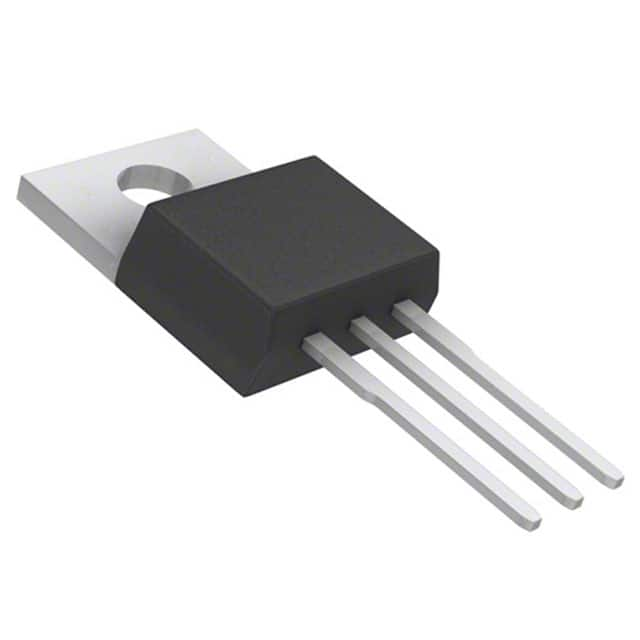FQP5N90
Product Overview
Category
The FQP5N90 belongs to the category of power MOSFETs.
Use
It is commonly used in power supply applications, motor control, and other high-power switching circuits.
Characteristics
- High voltage capability
- Low on-resistance
- Fast switching speed
- Low gate charge
Package
The FQP5N90 is typically available in a TO-220 package.
Essence
This MOSFET is essential for efficient power management and control in various electronic systems.
Packaging/Quantity
It is usually packaged in reels or tubes, with quantities varying based on manufacturer specifications.
Specifications
- Drain-Source Voltage (VDS): 900V
- Continuous Drain Current (ID): 5A
- On-Resistance (RDS(on)): 1.6Ω
- Gate-Source Voltage (VGS): ±30V
- Total Gate Charge (Qg): 18nC
- Operating Temperature Range: -55°C to 150°C
Detailed Pin Configuration
The FQP5N90 has a standard pin configuration with three pins: gate (G), drain (D), and source (S).
Functional Features
- High voltage capability allows for use in high-power applications.
- Low on-resistance minimizes power loss and improves efficiency.
- Fast switching speed enables rapid response in switching circuits.
Advantages
- Suitable for high-voltage applications
- Low power dissipation
- Enhanced efficiency in power management
Disadvantages
- Sensitive to static electricity
- Requires careful handling during installation
Working Principles
The FQP5N90 operates based on the principles of field-effect transistors, where the voltage applied to the gate terminal controls the flow of current between the drain and source terminals.
Detailed Application Field Plans
Power Supply Systems
The FQP5N90 can be utilized in various power supply systems, including switch-mode power supplies and uninterruptible power supplies, due to its high voltage capability and low on-resistance.
Motor Control
In motor control applications, this MOSFET can be employed to drive and control the speed of motors efficiently.
High-Power Switching Circuits
Its fast switching speed makes it suitable for high-power switching circuits such as inverters and converters.
Detailed and Complete Alternative Models
- IRF840: Similar voltage and current ratings
- STP5NK90Z: Comparable characteristics and performance
In conclusion, the FQP5N90 power MOSFET offers high voltage capability, low on-resistance, and fast switching speed, making it suitable for various power management and control applications. However, it requires careful handling due to its sensitivity to static electricity. Its working principles are based on field-effect transistors, and it finds extensive use in power supply systems, motor control, and high-power switching circuits. Alternative models such as IRF840 and STP5NK90Z provide similar functionalities and can be considered based on specific application requirements.
Word Count: 411
Senaraikan 10 soalan dan jawapan biasa yang berkaitan dengan aplikasi FQP5N90 dalam penyelesaian teknikal
What is FQP5N90?
- FQP5N90 is a power MOSFET transistor designed for high-voltage, high-speed power switching applications.
What are the key features of FQP5N90?
- FQP5N90 features include a low on-resistance, fast switching speed, and high voltage capability, making it suitable for various power electronics applications.
What are the typical applications of FQP5N90?
- FQP5N90 is commonly used in switch mode power supplies, motor control, lighting ballasts, and other high-power electronic circuits.
What is the maximum voltage and current rating of FQP5N90?
- FQP5N90 has a maximum voltage rating of 900V and a continuous drain current rating of 5A.
How does FQP5N90 compare to similar MOSFETs in its class?
- FQP5N90 offers a good balance of performance, cost, and reliability compared to other MOSFETs in its category.
What are the thermal considerations when using FQP5N90 in a design?
- Proper heat sinking and thermal management are important to ensure that FQP5N90 operates within its specified temperature limits for optimal performance and reliability.
Are there any specific layout or PCB design considerations for using FQP5N90?
- It's important to minimize parasitic inductance and capacitance in the layout to optimize the switching performance of FQP5N90.
Can FQP5N90 be used in automotive applications?
- FQP5N90 can be used in certain automotive applications, but it's essential to ensure that it meets the specific requirements and standards for automotive-grade components.
What are the common failure modes of FQP5N90 and how can they be mitigated?
- Common failure modes include overcurrent, overvoltage, and thermal stress. Proper protection circuits and derating guidelines should be followed to mitigate these risks.
Where can I find detailed technical specifications and application notes for FQP5N90?
- Detailed technical specifications and application notes for FQP5N90 can be found in the manufacturer's datasheet and application guides, which provide comprehensive information on using FQP5N90 in various technical solutions.


